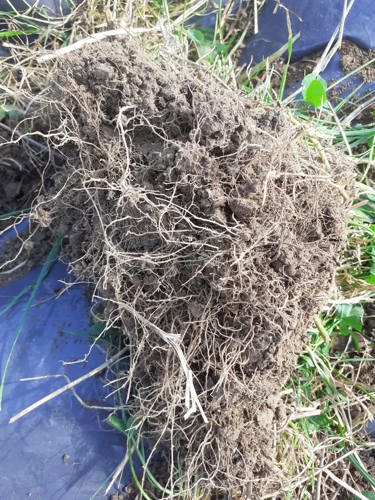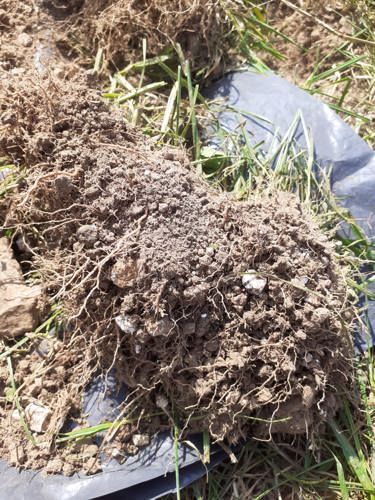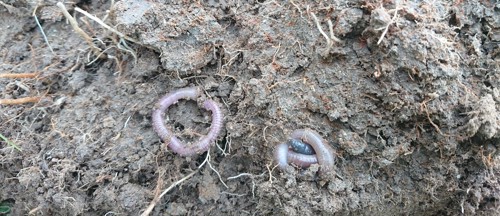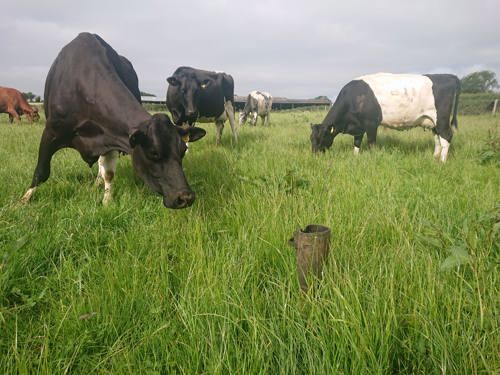

This field lab will investigate the impact of a longer rest period/taller sward height on soil health characteristics, particularly soil fungi, bacteria as well as other physical and chemical characteristics. The group are interested in whether they can implement longer grass resting periods without risking drop in milk quality and yield.
There is increasing interest and experimentation in ‘tall grass’ grazing and extended rest periods in grazing rotations to improve soil health, build soil organic matter and ultimately produce more forage growth.
This trial considers the rest period of the sward (e.g. effect of tall grass) and the incorporation/length of residual, as both of these are thought to have a positive effect on soil health.
If the farmers in the trials can demonstrate that there is some improvement in soil health characteristics by leaving grass to rest longer in the rotation without any negative impact on forage quality and milk yield, this will enable further practical evidence on how grazing practices can improve soil health.
‘Tall grass’ grazing is a type of rotational grazing that involves:
Examples of similar grazing practices include ‘mob’, ‘cell’, ‘adaptive multi-paddock’ and ‘regenerative’ grazing.
These approaches have had greater uptake by beef and sheep famers where animals are less sensitive to drops in forage quality. The nutritional content of grasses changes as they become taller (older), due to lignification, with the fibre content increasing but available sugars reducing. Dairy cows require a high calorific demand so there are concerns that more fibrous grass will not have the sugar content required. Additionally, many dairy farmers’ leys are dominated by rye grass which has been bred to provide maximum sugar and leaf at a young growth stage. The plants also don’t have the rooting depth to provide some of the soil benefits achieved from tall grass grazing.
Due to these factors, dairy farmers have been more cautious to adopt and potentially benefit from these alternative grazing approaches.
It is thought the greater leaf area and therefore increased opportunity for photosynthesis leads to increased root growth and depth; in turn, increased root mass helps feed the soil microbes (e.g. bacteria and fungi) which leads to improved overall soil health.
The farmers in this field lab will adopt an approach that works for their system whilst ensuring an extended rest period and comparing the soil response under the trial area to other fields in the “conventional” rotation.
Trials will take place on six farms over three years.
Each farmer will choose a field to split, or choose two fields with similar sward types and sward composition. One field or part of field will be the control plot which will be managed as routine within the grazing rotation.
The other half of the field will be the treatment plot, and management protocols are as follows:
The group met in September at triallist Dan Gammon’s farm for a catch up and discussion. It was a tricky spring which meant that some of the trial plots had to be grazed harder in April due to drought and lack of grass, and some were then damaged by the wet weather.
The trial has highlighted the lengthy timeframe required for improving soils: changes to soil biology and organic matter happen over a long time period, and you cannot expect big changes very quickly. So if you’re trying a new management technique like this don’t be disheartened if there’s been limited change after a few years!
In the main the trials are going well, here are some interesting outcomes from the group meeting:
Milking has been fine on long grass: no drops in yield at any of the trial farms who were represented at the meeting. However, on one farm the herdsman had trouble with the milking, as the cows were filling up on the long grass in the trial plot. Then after milking they were not eating their next allocation as they were so full. They’ve split the grazing now so they’re grazing 1 night and 1 day on the tall grass which has helped this situation – but its something to be aware of if you’re trying this.
Soil
The group dug a soil pit in Dan’s trial plot. The soil structure scored really well (1 on the VESS scale), lots of earthworms (12), and really good dense root matter.

The soil pit in the control field also scored 1 on the VESS scale and and had a high number of worms (20) but the roots were not as dense as in the trial side. This might be because the trial field was put to standing hay last year, or it might be because leaving the sward for longer allows it to put down more roots between grazing.

Those farmers who are trialling the practice on their already good fields have found that the practice has accelerated improvement. It has taken longer to kickstart the improvement on the poorer soils.
The group looked at soil samples under the microscope. Anecdotally they saw more organic matter and fungi in soil of trial plot, but this has not been tested in the lab yet. The group are waiting as long as possible before sending samples to the lab ato maximise the time over which change can happen.
Dan noticed that on his treatment side the cow pats were broken down more quickly and there was more surface fungi around cow pats than on the control side. This may suggest more active soil biology or more moisture levels.

The group noticed that the treatment had very good ground cover which kept the soil moist, whereas the control growth was more open, so more at risk of drying out. A denser root structure and higher soil moisture creates a more resilient sward.
Matt Preston has won Grassland Farmer of the Year Award!
British Grassland Society competition
Dan is extending the practice of letting the grass grow longer before allowing the cows in beyond the trial field: he finds it is working for him in terms of grazing management.
The group really value the benefits of a specific grazing discussion group and the sharing or knowledge and experience, as well as the group dynamic to encourage them.
Like many livestock farmers, the group had a challenging spring with prolonged dry weather significantly impacting grass growth, so after an initial graze in early spring, second grazes have been after a much longer round.

The group gathered for a webinar with Siobhan Griffin of Next Level Grazing, who has been mentoring some of the triallists as part of their training with Arla around regenerative farming approaches. This was to understand her approaches to optimal grazing height and protecting your grazing wedge.
This was a very valuable session for the group and made a number of the farmers aware that they had let the sward grow too high in grazing rounds last year, with too much “brown” growth, impacting on milk yield and ability of the third of trodden sward to break down.
Here are some details of the session on the IF website: https://www.innovativefarmers.org/news/how-to-build-a-more-resilient-grazing-operation/
There was lots of discussion around the trial at Groundswell. Dan presented as part of a SA led session on Farmer-Led Solutions to Underperforming Fields & Marginal Land (you can watch the recording on youtube by clicking on the link). Tom and Debbie discussed the trial in a session led by FAI on regenerative grazing for dairy.
The group needs to come together this autumn to discuss any soil and forage data we want to collect and confirm approach to forage sampling for spring 24 so everyone is prepared to collect samples at the same time and agree on analysis. The group meeting will also be used to discuss how the 2023 grazing season has gone more generally.
Farmers from three of the trial farms met with coordinator Kate Still and Becky from Farm Carbon Toolkit at Old Burford Farm last week to catch up on the progress of the field lab.
We first looked at the progress of the trial plots over the grazing season, and the experiences on the different farms. It was agreed that the severe drought over the summer had made for a difficult grazing season, though in general the trial plots performed well.
Sward Quality
Soil Test Results
The results from the initial soil tests were then discussed, and we were lucky to have Becky Wilson from Farm Carbon Toolkit with us to guide us through the baseline soil data.
The soils were tested in May/June 22, the full testing will be repeated in Spring 25. The plots have been GPS tagged so the exact same places can be sampled again next year. In general the statistics showed that there was no significant difference between the soil test results, but this was to be expected at this baseline stage of the trial.
There were some differences which were not statistically significant but which are a good indication of soil improvement during the trial:
It is expected that a greater statistical difference will be seen in the next samples: hopefully a further shift from bacteria-dominated soil to higher fungi levels in the trial sites. The next round of soil sampling will include infiltration tests, these were not completed in 2022 due to excessively dry conditions.
Next year when the triallists will be looking at doing some soil assessments themselves, including worm counts, infiltration, VESS and also they are looking to include a dung beetle count in the trial as this is usually a good sign of soil health.
All the triallists started with pretty good soils, but because they are so varied the group discussed how to ensure they can produce useful and robust outcomes.
A look at the Trial plots
The group then braved the elements and went to look at the trial plots. The soil in both control and trial plots was still very dry below the first few inches from the drought, despite the driving rain on the day. It was felt to be a good sign that three worms were found in the soil in the trial plot and none in the control!
Overall it was a very successful gathering, and reinforced enthusiasm in the group.
This trial is looking at both the rest period of the sward (e.g. effect of tall grass), and the incorporation/length of residual as part of grazing strategy as both of these are thought to have a positive effect on soil health. Leaving higher residual allows for continued photosynthesis and root structure, whilst trampling adds nutrients to the soil.
Trials will take place on six farms over 3 years. Trial protocols are as follows:
Split a field or choose two similar soil type fields, with similar sward composition. Restrict choice of field to those that haven’t been cultivated within the last 2 years and no cultivation should take place in the study fields for the next 3/5 years to ensure stability of soil.
Control plot: Manage as routine within the grazing rotation
Treatment plot:
- Aim to allow pre graze sward growth to reach a height 30 – 50% taller than in control field, with an aim where suitable, of an entry cover c. 4500 kg/DM per ha
- Apply a 1/3 eaten, 2/3 residual/trampling approach – with stock removed at a a minimum 7 cm or 2000 – 2500 kg/DM per ha.
- Apply a stocking rate/land parcel size to meet forage needs of group of cows. Treatment and control fields can be split into multiple grazing cells/paddocks depending on size/forage need of the group of stock. The control and treatment paddocks can be grazed at different points within the grazing rotation as long as the entry and exit sward height of the control field is in line with he “standard” rotation and the entry and exit approach of the treatment field is in line with above.
Data already being collected by the farmers:
- Pasture covers (plate meter data) (due to concerns over accuracy of plate meters, especially with diverse leys, farmers will also measure sward height and where possible, cut and weigh a quadrat sample to get accurate kg fresh weight and DM, before the animals go into graze.
Data collection in April 2022 (Baseline testing) and comprehensive data collection at the end of three grazing periods year 3 (October 2024) as detailed below. Additional physical soil assessments will be completed in 2023 and 2024 as part of field lab meetings. This soil assessment strategy has been put in place to make best use of the budget and in recognition of the slow change in the chemical and biological characteristics of soils.
The Farm Carbon Toolkit will undertake assessments on both the control and treatment fields:
- Soil Organic Matter 0-10cm, 10-30cm, 30-50cm
- VESS Scoring
- Infiltration rate
- Worm count
- Nutrient analysis
- Aggregate Stability
- Bulk density
- Biological activity using soil my undies protocol
For more information about the Farm Carbon Toolkit’ soil testing methodology and these tests, visit: farmcarbontoolkit.org.uk/toolkit-page/measuring-soil-health.
Additionally using SoilBioLab, soil bacteria and fungi lab tests will be completed for control and treatment fields. Baseline samples will be completed in April 2022. Final testing may be completed in October 2025 at the end of the grazing season, but following review, may be carried on in April 2026 allowing for the resting effect of the winter period.
Following tests:
- Moisture Content
- Active and Total Fungi
- Active and Total Bacteria
- Hyphal Diameter
- Organism Ratios
Forage analysis
To understand the impact of changes in soil health and mineral availability there will be the opportunity where farmers can commit to collecting their own forage samples to carry out micro mineral forage analysis twice in the year in the baseline year 1 (2022) and year 3 (2024), with a quadrat being cut pre graze. Standard Forage analysis (NIRS) will be completed by Sciantec.
9th December 2021
15th May 2022
15th September 2022
15th September 2023
15th September 2024
15th April 2025
15th June 2025

Soil Association
South West England
Specialist in animal welfare; dairy and sheep farming experience; former farm business consultant and advisor on agri-environment schemes and conservation; Animal Welfare Advisor on AssureWel, Soil Association. Kate is assisting in group co-ordination and additionally working on another project (RELACS) focusing on antibiotic reduction and udder health. This field lab with provide beneficial information to the farmers in the RELACS project.

Home Farm
Devon

Somerset

Somerset

Dorset

Oak Vale Farms
Dorset

Norton Court Farm
Gloucestershire

Shropshire